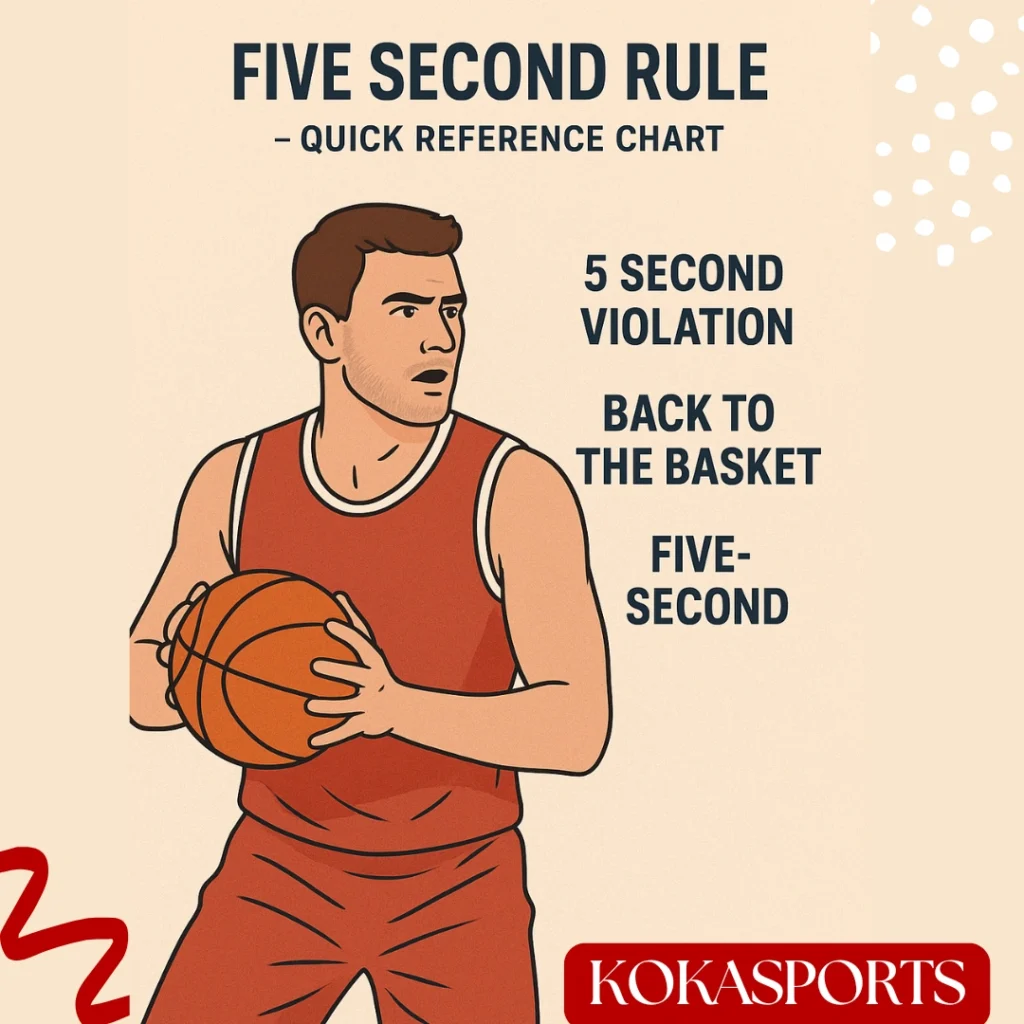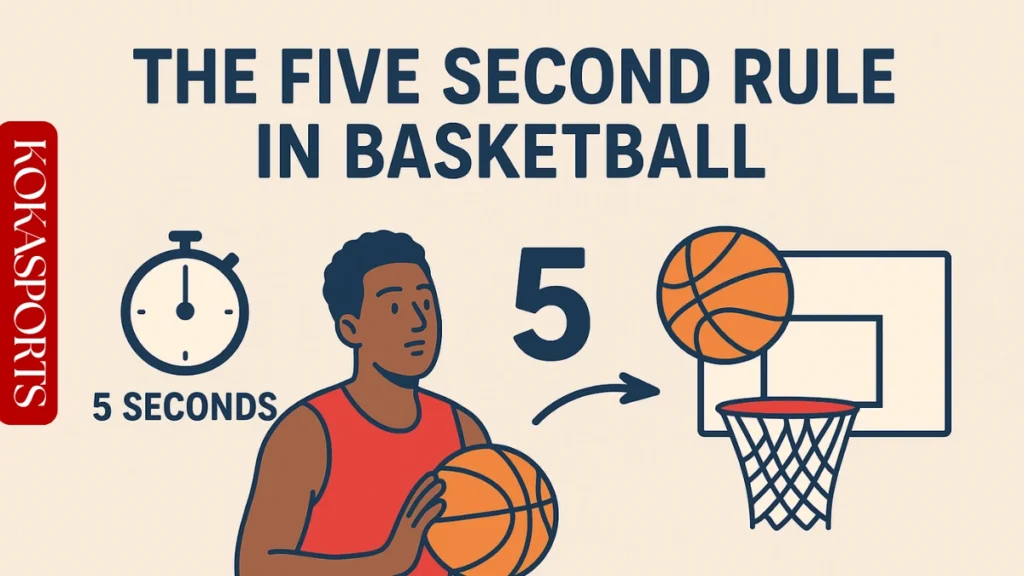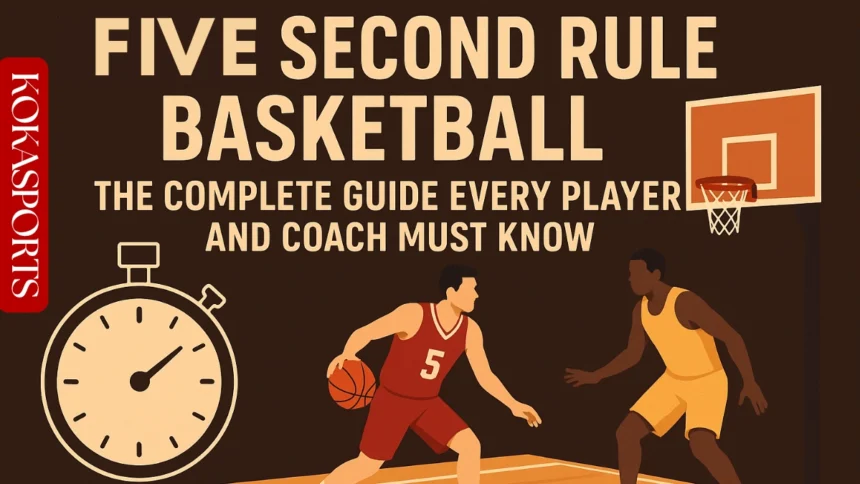Have you ever watched a basketball game and seen the referee blow the whistle for no reason? Then the other team gets the ball? This might be because of the five second rule in basketball. This rule is very important but also very simple to understand.
The five second rule in basketball stops players from holding the ball too long. It keeps the game moving fast and fun to watch. Without this rule, players could just stand around with the ball and make the game boring.
Let’s learn everything about this rule in simple words that anyone can understand.
What is the Five Second Rule in Basketball?
The 5 second rule is not just one rule. It has different parts. But they all have one thing in common – players only get 5 seconds to do something with the ball.
Think of it like this: when you play games at home, there are rules to make it fair. Basketball has rules too. The five second rule in basketball makes sure no player takes too much time.
The rule happens in three main ways:
- When throwing the ball back into the game
- When a player holds the ball and a defender is very close
- When shooting free throw shots (but this is different in some games)
Each way has its own rules. But they all want the same thing – keep the game moving!
Five Second Rule — Quick Reference Chart
| League / Level | Throw-In Rule | Closely Guarded Rule | Free Throw Time Limit |
|---|---|---|---|
| High School (NFHS) | 5 seconds to inbound | Defender within 6 feet, frontcourt only, counts when holding or dribbling | 10 seconds |
| College Men (NCAA) | 5 seconds to inbound | Defender within 6 feet, frontcourt only, counts only when holding | 10 seconds |
| College Women (NCAA) | 5 seconds to inbound | Defender within 3 feet, anywhere on court, counts only when holding | 10 seconds |
| NBA | 5 seconds to inbound | No standard closely guarded rule in live play | 10 seconds |
| NBA – Special | — | Back-to-basket rule: 5 seconds max while dribbling in post area | — |
| FIBA / International | 5 seconds to inbound | Defender within 1 meter (~3 feet), anywhere, counts only when holding | 5 seconds |
Read More: Three Second Rule Basketball: Complete Guide
Five Second Rule in Basketball: Throwing the Ball In

The most common 5 second problem happens when teams try to throw the ball back into the game. This is called a throw-in.
Here’s how it works: When a player gets the ball to throw it in, they have exactly 5 seconds. The referee starts counting right away. The player must release the ball before those 5 seconds end.
It doesn’t matter if the pass is good or bad. As long as the ball leaves their hands within 5 seconds, there is no throw-in violation.
This rule is very important in close games. The other team knows about this time limit. So they will try to guard very closely to make it hard to throw the ball in.
Good coaches teach their players to have a backup plan. They always have one player ready to catch the ball if the main plan doesn’t work. This way, they don’t run out of time.
The Closely Guarded Five Second Rule in Basketball
This is where the 5 second rule gets a bit tricky. Different basketball games have different rules. But don’t worry – we’ll make it simple.
The basic idea is this: when a defender is very close to an offensive player with the ball, the offensive player has only 5 seconds. They must pass, shoot, or dribble within this time.
But how close is “very close”? This changes based on what type of basketball you’re watching.
High School Basketball and the 5 Second Rule
In U.S. high school basketball (NFHS rules), the defender must be within six feet of the player with the ball, and this only applies in the frontcourt.
The count keeps going even when the player starts dribbling, so dribbling doesn’t stop the count.
In other countries, high school leagues may follow FIBA rules, which are different.
Also, if one defender moves away and another defender comes close, the counting continues. The defensive player doesn’t have to be the same person the whole time.
College Basketball Rules for 5 Second
College basketball has different rules for men and women. This might sound confusing, but it’s actually simple:
Men’s College Basketball: The defender must be within six feet. But the 5 second count only happens when the offensive player is holding the ball without dribbling. Once they start to dribble, the count stops.
Women’s College Basketball: The guard only needs to be within three feet (that’s closer). And this can happen anywhere on the court, not just the frontcourt. But like men’s rules, the player is holding the ball, not dribbling.
Professional Basketball and the 5 Second Rule
The NBA does not have a standard ‘closely guarded’ rule during normal live play like high school or college.
The two main cases are:
Throw-in plays: 5 seconds to inbound the ball, same as other leagues.
Back-to-the-basket violation: If a player is dribbling with their back to the basket near the post area, they have only 5 seconds to make a move.
This stops players from backing down toward the basket for too long. It’s called a back to the basket violation.
Free Throw and the Five Second Rule in Basketball
When players shoot free throw shots, they also have time limits. But this is different from the other 5 second rules.
In international (FIBA) games, players have only 5 seconds to shoot their free throw.
In American basketball NBA, NCAA, and U.S. high school players get 10 seconds.
This gives players time to get ready and take a good shot. But they can’t take forever.
How to Know When the 5 Second Count is Happening

The referee helps players know when the count is happening. They use hand signals that are easy to see.
When a defender is too far away, the referee holds both arms out wide. This means “no counting happening.”
But when the defender gets close enough and is guarding the player closely, the referee starts moving one arm up and down. This means “I’m counting! You have 5 seconds!”
Smart players always look at the referee. If they see the arm moving, they know they need to do something fast. If the referee’s arms are out wide, they can keep doing what they’re doing.
Why Teams Try to Force Five Second Rule in Basketball Violations
Good defensive teams don’t just wait for mistakes. They try to make the other team break the 5 second rule.
Here’s how they do it:
Press and Pressure: They guard very closely during throw-in plays to make it hard to find an open player.
Switch Defenders: When one defender gets tired, another one comes close. This keeps the pressure on and the counting going.
Study the Other Team: They watch videos to learn what plays the other team likes. Then they can be ready to stop those plays.
Block the Easy Pass: They make sure the easy passes are not available. This forces harder decisions.
The defensive player who understands timing can create big problems for the opposing team.
Common Mistakes Players Make with 5 Second Rule
Even good players sometimes make mistakes with the 5 second rule. Here are the most common ones:
Getting Scared
When players hear the referee counting, they sometimes panic. They make bad passes or take bad shots because they’re worried about time. But 5 seconds is actually enough time to make a good play if you stay calm.
Not Moving
Some players forget they can move when they’re being guarded closely. If the offensive player in his frontcourt takes a quick step and gets past the defender, the count stops and starts over.
Bad Communication
During throw-in plays, teammates sometimes run to the wrong places. The player making the throw-in needs seconds to throw the ball to someone open. But this only works if everyone knows the plan.
Not Watching the Defense
Some players focus so much on their plan that they don’t see what the defense is doing. It’s important to notice when you’re being guarded by an opponent who is making things difficult.
How Coaches Teach the Five Second Rule in Basketball
Good coaches make sure their players understand the 5 second rule. They practice it a lot so players don’t make mistakes in real games.
For Throw-In Plays
- Pick one good player to throw the ball in who can think fast
- Practice with someone counting out loud: “1… 2… 3… 4… 5!”
- Always have a backup plan if the first option doesn’t work
- Sometimes use tall players who can see over the defenders
For Closely Guarded Plays
- Teach players to watch the referee’s hands
- Practice quick moves that can break free from close guard
- Work on strong dribbling so players don’t lose the ball when under pressure
- Do drills where players must decide what to do very quickly
Mental Training
- Help players understand that 5 seconds feels shorter when you’re nervous, but it’s actually enough time
- Practice making decisions quickly
- Build confidence so players don’t get scared when the counting starts
The Mind Game of the Five Second Rule in Basketball

The 5 second rule is not just about time. It’s also about what happens in players’ minds.
When the referee starts counting, players can feel pressure. Some players like this pressure. It makes them play better and make smart, quick moves.
Other players don’t like pressure. They get worried and make mistakes even when they still have time left.
Smart defenders know this. They will get close to a player not just to steal the ball, but to make that player feel pressure. Sometimes just making someone feel rushed works better than trying to steal the ball.
Different Basketball Games Have Different Rules
Not all basketball games use the exact same rules. Here’s a simple breakdown:
High School: Defender must be within six feet, counts in frontcourt, works when holding or when they dribble
College Men: Defender must be within six feet, counts in frontcourt, only when holding the ball without dribbling
College Women: Defender must be within three feet, counts anywhere on court, only when holding
NBA: Mostly for throw-in plays, plus special rules for players who dribble with his back toward the basket
International (FIBA) games: The defender must be within one meter (about three feet). The count can happen anywhere on the court, but it only applies when the offensive player is holding the ball, not dribbling.
Players who play different types of basketball need to remember these differences.
Other Time Rules in Basketball
The five second rule in basketball works together with other time rules. These all help keep the game moving:
3-Second Rule: Offensive players can’t stay in the small rectangle under the basket for more than 3 seconds
8 Seconds Rule: Teams must move the ball from their back court to the frontcourt within 8 seconds
Shot Clock: Teams must try to score within a certain time (usually 24 seconds in professional games)
All these rules work together to make basketball fast and exciting.
How the Five Second Rule in Basketball Helps the Game
The 5 second rule makes basketball better in many ways:
Keeps Games Exciting: Without this rule, players could hold the ball forever and make games boring
Rewards Good Defense: When defenders work hard to guard closely, they get rewarded if they can force a violation
Makes Players Better: Players must learn to think and act quickly, which makes them better at basketball
Creates Strategy: Coaches must plan for these situations, which makes the game more interesting
Helps Fans Understand: When fans know the rules, they enjoy watching more
Tips for New Players Learning the Five Second Rule in Basketball
If you’re new to basketball, here are simple tips:
- Don’t Panic: When you hear counting, stay calm. 5 seconds is more time than it sounds like.
- Keep Your Head Up: Always look around to see what your options are.
- Practice at Home: Ask someone to count while you practice dribbling or passing.
- Watch the Referee: Learn to see their hand signals so you know when counting is happening.
- Have a Plan: Always think about what you’ll do if a defender gets too close.
- Stay Strong: Hold the ball tight so defenders can’t knock it away.
What Happens When Someone Breaks the Five Second Rule in Basketball
When a player breaks the 5 second rule, here’s what happens:
- The referee blows the whistle
- The other team gets the ball
- The game continues from where the violation happened
- No players get in trouble (it’s not a bad foul, just a rule break)
It’s like a turnover. Your team loses the ball and the opposing team gets a chance to try to score.
Famous Games and the 5 Second Rule
The five second rule in basketball has decided some famous games. Sometimes a team loses because they couldn’t get the ball in within 5 seconds. Other times, smart defense has won games by forcing these violations.
Professional players practice these situations hundreds of times. Even they sometimes make mistakes when the pressure is high and the game is important.
Why Everyone Should Learn the Five Second Rule in Basketball
Understanding this rule helps everyone enjoy basketball more:
Players: You won’t make easy mistakes that cost your team points
Coaches: You can teach better and help your team win more games
Fans: You’ll understand why referees make certain calls
Parents: You can help your kids learn and enjoy basketball
The five second rule in basketball might seem small, but it’s actually very important. It keeps games fair, fast, and fun for everyone.
Summary
The five second rule in basketball is really about keeping the game moving. Players get 5 seconds to:
- Throw the ball in during throw-in plays
- Make a move when a defender is guarding closely
- Shoot free throw shots (in some games)
When players break these rules, the opposing team gets the ball. The best way to avoid problems is to stay calm, practice hard, and always have a plan.
Basketball is more fun when everyone understands the rules. The five second rule in basketball helps make sure games stay exciting and fair for everyone playing and watching.
Remember: 5 seconds might not sound like much time, but it’s enough to make a good play if you’re prepared and stay calm. Practice these situations and you’ll become a much better basketball player!
FAQs
What is the 5-second rule in basketball?
A player has five seconds to act or inbound before a violation.
What is rule 5 in basketball?
It covers five-second time limits in certain plays.
What do you mean by the 5-second rule?
A rule giving players only five seconds to move.
How to count 5-second violations in basketball?
The referee counts until the ball is released.




